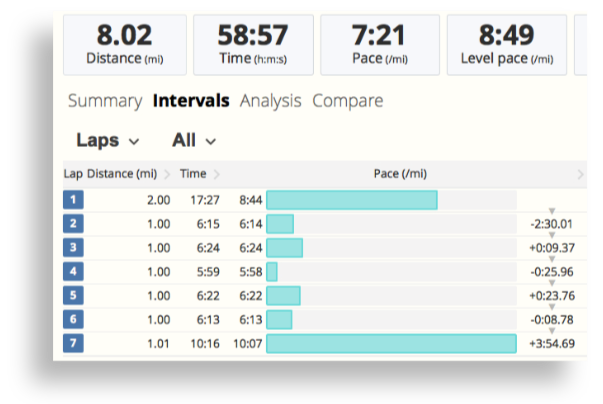Understanding Pace in Running
Why runners use pace, and the many benefits it provides
When you drive too fast in a vehicle, you can get in trouble with the police, but when you run too fast too early in a race — you can penalize yourself with a slower finish time. The speedometer tells you how fast you're going in a car, but in running, you measure your speed with pace data on a GPS watch or a mobile app. Even though pace is absolutely essential in running, the basics are often glossed over or ignored completely. The point of this article is fill in these blanks so we all can can have a stronger understanding of pace.
Why do runners use pace to measure speed?
Running is an old sport, and the ability to glance at a watch to see how fast you're going is still new. In the recent past, if a runner wanted to know how fast they were traveling, they would need a stopwatch and a course that was pre-measured for distance, such as a running track. A single lap on a standard track is 400 meters, and four laps equal a mile. A common practice was to start a stopwatch, run four laps, then hit stop. The resulting time was your mile pace.

This is one of the reasons we don't use miles per hour (or kilometers per hour) in running, as we do in motor vehicles. An exception here are treadmills, which often do use mph and kph, making the experience of indoor running a bit more frustrating for seasoned runners. If you're new to the sport, the numbers involved with pace take a short amount of time to get familiar with, but once you do, you realize they provide many benefits:
- Pace gives you an immediate sense for how long it takes to cover distances in your runs.
- Popular races like the 5K are completed in well under an hour, which makes using pace more applicable.
- Pace numbers seem more satisfying. Running a mile in 6:40 (4:08/k) feels like more of an achievement than running a mile at 9.07 mph (14.6 kph).
- Slight differences in mph (and kph) seem insignificant, but they're not:
| 8.57 mph | = | 7:00/mi |
| 8.55 mph | = | 7:01/mi |
| 13.79 kph | = | 4:21/k |
| 13.74 kph | = | 4:22/k |
1 second faster is significant. It's the difference between 1st and 2nd place. Another great thing about using pace data in running is that the "splits" are useful for managing your races in an organized way.
What are splits in running?
A split is the amount of time it takes to run a specific distance, such as a mile or a kilometer. A 5K race will have 3 separate mile splits, or 5 separate kilometer splits. When you cross the starting line at a race and hit the Start button on your watch or device, you can check your split times at each mile (or kilometer) marker to see if your pace is on target to achieve your goal time. In races longer than the 5K, if you start off running too quickly, you will tire and slow down for the latter part of the race. Many runners strive for a "negative split", which means they ran the second half of the race faster than the first.
Your GPS watch will likely automatically display your splits every time you do a training run. Similarly, when you look at your data after you work out, you will see splits displayed in charts. SportTracks shows your splits in the Intervals tab on a Workout Detail page, where you can directly compare them to changes in elevation, your heart rate, cadence, calories, and run power data.
How to improve pace in running
One of the best ways to improve your pacing is to intentionally practice it. You should know how to run at marathon pace, half marathon pace, 10K pace, and 5K pace. A good way to determine these paces for yourself is to visit the SportTracks Labs Race Finish Time Predictor. Enter in a race time you have previously run (if you haven't raced yet, enter a time and distance of a fast training run). The calculator will instantly display your predicted finish time with the pace required to achieve it. You will see predicted paces for many distances.
When you're out running, intentionally practice locking into different paces. Start with your slower marathon pace, hold it for 2 minutes, then recover for 2 minutes. Then do a 2-minute interval of half marathon pace, followed by 2 minutes of recovery. Next try to hold your predicted 10K pace for 2 minutes, then spend two minutes recovering. The point is to learn what it feels like to hold different paces. Practice this often. Analyze your data afterwards to verify what you felt, to see if your heart rate consistently followed the intervals up and down, etc.
Hopefully any lingering misunderstanding you had about the basics of pace in running are gone and you can confidently stride away at your future races. If you want to learn more about the basics of run training, read our articles on Heart-Rate 101 and Running Form 101.
| Article written by Sam Mallery, Director of Marketing, Zone Five Software Inc. |

